A tornado has been confirmed by the National Weather Service (NWS) in Southern California.
It happened Tuesday in the town of Carpinteria, Santa Barbara County. The NWS confirmed it was an EF0 category tornado with winds estimated at 75 miles per hour.
Another possible tornado hit the town of Montebello on Wednesday morning, leaving several businesses with significant damage and at least one person injured.
The NWS is still investigating the extent of the phenomenon in Montebello and will provide more information on the category of the phenomenon at a later date.
According to the NWS, “A tornado is a column of air that expands violently from the base of a thunderstorm down to the ground. Tornadoes are capable of completely destroying structures, trees, and throwing objects through the air like deadly missiles.
Although these events are not common in California, “tornadoes can occur at any time of the day or night and at any time of the year. Although tornadoes are more common in the Central Plains and Southeastern United States, they have been reported in all 50 states,” the NWS reported.
Hundreds of residents witnessed a tornado in Montebello on Wednesday morning, and they shared their experience with Telemundo 52 and NBCLA.
These tornadoes that took Southern Californians by surprise who were only expecting rain and snow as an atmospheric river passed through the area.
“Tornadoes are formed by winds that are on the surface, the ones you feel when you leave the house, but also with higher and stronger winds in the sky,” said Marcos Mora, presenter for Telemundo 52.
“Now, when you have this type of wind not only on the surface, but also in the lower levels of the atmosphere, (it forms) a rotating column, and that, together with the instability of thunderstorms, and updrafts, will lead to a rotating column of air,” Mora added.
Mora added that “when that column starts getting closer and closer to the surface and when it hits the ground, that’s when there’s a tornado.”
If the column does not touch the ground, it is known as a funnel cloud and is not considered a tornado.
A subterranean waterspout is a weaker vortex of wind which, according to the World Meteorological Organization, is a “tornado that does not result from an organized rotation on the scale of the storm and is therefore not associated with clouds walls (murus) or to a mesocyclone”.
Tornadoes are measured using the so-called Enhanced Fujita (EF) scale in which the severity of the event is classified.
- Low: Category EF-0 with speeds between 65 mph and 85 mph.
- Low: EF-1 category with speeds between 86 mph and 110 mph.
- Strong: EF-2 category with speeds between 111 mph and 135 mph.
- Strong: category EF-3 with speeds between 216 km/h and 265 km/h.
- Violent: Category EF-4 with speeds between 166 mph and 200 mph.
- Violent: Category EF-5 with speeds over 200 mph.
According to the NWS, tornadoes in California mostly occur in the spring and fall, and their magnitude usually does not exceed EF-3 strength, which is 165 mph. The NWS is the only federal agency with authority to issue tornado warnings.
Tornadoes are rare, but not unprecedented in Southern California.
Una advertisement de tornado se emitió hace 40 años cuando un tornado convientos de entre 113 y 157 mph barrió los vecindarios al sur del centro de Los Ángeles, destruyendo casas y negocios, volteando autos, arrojando escombros y dégarrando parte del techo del Centro de Convenciones from the city.
How to protect yourself during a tornado?
The NWS ensures that it is important to prepare for this type of weather event which can occur on almost all of the national territory.
- Stay informed of weather advisories in the area where you live.
- Develop a safety plan and communicate it to your loved ones.
- During a tornado, seek shelter in the lowest area of your home, preferably in the basement, or somewhere away from windows.
- If you are outside a house or building, seek shelter in a secure structure as soon as possible.
- If you are in a vehicle, try to get out and take shelter in a structure such as a building or a house.

